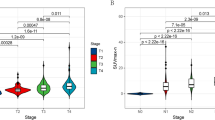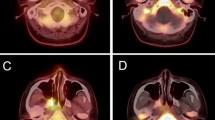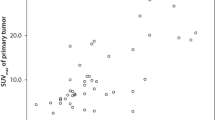Abstract
Purpose
To evaluate the prognostic value of maximal standardized uptake values (SUVmax) from serial fluor-18-fluorodeoxyglucose positron emission tomography/computed tomography (18F-FDG PET/CT) in patients with nasopharyngeal carcinoma (NPC).
Materials and methods
Fifty-two patients with NPC who underwent 18F-FDG PET/CT scan before radiotherapy with/without chemotherapy were reviewed retrospectively. Twenty-seven patients (52%) were applied 3-D conformal radiotherapy and 25 patients (48%) applied intensity-modulated radiotherapy (IMRT). Fourteen (27%) patients were given neoadjuvant chemotherapy and forty-four (84.6%) patients were given concomitant and adjuvant chemotherapy.
Results
Median follow-up time was 34 months (range 5.6–66.4 months). Forty-four (84.6%) patients were alive at last follow-up and eight (15.4%) had died. The best cut-off value of the SUVmax for the primary tumor site (SUVmax-PT) was 13 and 9 for the lymph nodes (SUVmax-LN). Patients with SUVmax-PT ≥ 13.0 and SUVmax-LN ≥ 9 had a significantly higher risk for the development of the distant metastases (p = 0.044 and p = 0.038). DFS was affected in patients with SUVmax-PT ≥ 13 (log rank χ 2 = 2.54, p = 0.017) and was significantly lower in patients with SUVmax-LN ≥ 9 for the lymph nodes (log rank χ 2 = 5.81, p = 0.013). OS was not affected by SUV levels. A multivariate Cox proportional hazard model of DFS included age (≥ 40), SUVmax-LN (< 9), T stage (T1–2) and neoadjuvant chemotherapy are significantly better prognosis for the DFS.
Conclusion
18F-FDG PET/CT uptake before treatment, as determined by SUVmax, may be a valuable tool to evaluate prognosis in NPC patients.









Similar content being viewed by others
References
Siegel RL, Miller KD, Jemal A (2017) Cancer statistics, 2017. CA Cancer J Clin 67:7–30
Wei WI, Sham JS (2005) Nasopharyngeal carcinoma. Lancet 365:2041–2054
Nwaorgu OG, Ogunbiyi JO (2004) Nasopharyngeal cancer at the University College Hospital Ibadan Cancer Registry: an update. W Afr Med J 23:135–138
Vasef MA, Ferlito A, Weiss LM (1997) Nasopharyngeal carcinoma, with emphasis on its relationship to Epstein-Barr virus. Ann Otol Rhinol Laryngol 106(4):348–356
Lee N, Kong L (2008) Nasopharyngeal cancer. In: Brady LW, Heilmann HP, Molls M, Nieder C (eds) Radiation oncology: an evidence-based approach. Springer, Berlin, pp 17–36
Karnell LH, Christensen AJ, Rosenthal EL, Magnuson JS, Funk GF (2007) Influence of social support on health-related quality of life outcomes in head and neck cancer. Head Neck 29:143–146
von Schulthess GK, Steinert HC, Hany TF (2006) Integrated PET/CT: current applications and future directions. Radiology 238:405–422
Buck AK, Herrmann K, Stargardt T, Dechow T, Krause BJ, Schreyögg J (2010) Economic evaluation of PET and PET/CT in oncology: evidence and methodologic approaches. J Nucl Med 51:401–412
Chang JT, Chan SC, Yen TC, Liao CT, Lin CY, Lin KJ et al (2005) Nasopharyngeal carcinoma staging by (18)F-fluorodeoxyglucose positron emission tomography. Int J Radiat Oncol Biol Phys 62(2):501–507
Liu FY, Chang JT, Wang HM, Liao CT, Kang CJ, Ng SH et al (2006) [18F] fluorodeoxyglucose positron emission tomography is more sensitive than skeletal scintigraphy for detecting bone metastasis in endemic nasopharyngeal carcinoma at initial staging. J Clin Oncol 24:599–604
Sham JS, Choy D (1990) Prognostic factors of nasopharyngeal carcinoma: a review of 759 patients. Br J Radiol 63:51–58
Lee AW, Poon YF, Foo W, Law SC, Cheung FK, Chan DK et al (1992) Retrospective analysis of 5037 patients with nasopharyngeal carcinoma treated during 1976–1985: overall survival and patterns of failure. Int J Radiat Oncol Biol Phys 23:261–270
Chua DT, Sham JS, Wei WI, Ho WK, Au GK (2001) The predictive value of the 1997 American Joint Committee on Cancer stage classification in determining failure patterns in nasopharyngeal carcinoma. Cancer 92:2845–2855
Cooper JS, Cohen R, Stevens RE (1998) A comparison of staging systems for nasopharyngeal carcinoma. Cancer 83:213–219
Nahmias C, Hanna WT, Wahl LM, Long MJ, Hubner KF, Townsend DW (2007) Time course of early response to chemotherapy in non-small cell lung cancer patients with 18F-FDG PET/CT. J Nucl Med 48:744–751
Xu X, Yu J, Sun X, Yang G, Li K, Fu Z et al (2008) The prognostic value of 18F-fluorodeoxyglucose uptake by using serial positron emission tomography and computed tomography in patients with stage III non-small cell lung cancer. Am J Clin Oncol 31:470–475
Lin C, Itti E, Haioun C, Petegnief Y, Luciani A, Dupuis J et al (2007) Early 18F-FDG PET for prediction of prognosis inpatients with diffuse large B-cell lymphoma: SUV-based assessment versus visual analysis. J Nucl Med 48:1626–1632
Allal AS, Slosman DO, Kebdani T, Allaoua M, Lehmann W, Dulguerov P (2004) Prediction of outcome in head-and-neck cancer patients using the standardized uptake value of 2-18F-fluoro-2-deoxy-glucose. Int J Radiat Oncol Biol Phys 59:1295–1300
Aktan M, Koc M, Kanyilmaz G, Yavuz BB (2017) Prognostic value of pre-treatment 18F-FDG-PET uptake in small-cell lung cancer. Ann Nucl Med 31(6):462–468
Chan SC, Kuo WH, Wang HM, Chang JT, Lin CY, Ng SH et al (2013) Prognostic implications of post-therapy (18)F-FDG PET in patients with locoregionally advanced nasopharyngeal carcinoma treated with chemoradiotherapy. Ann Nucl Med 27(8):710–719
NnYang Z, Shi Q, Zhang Y, Pan H, Yao Z, Hu S et al (2015) Pretreatment 18 F-FDG uptake heterogeneity can predict survival in patients with locally advanced nasopharyngeal carcinoma—retrospective study. Radiat Oncol 8(10):4
Delbeke D, Coleman RE, Guiberteau MJ, Brown ML, Royal HD, Siegel BA et al (2006) Procedure guideline for tumor imaging with 18F-FDG PET/CT 1.0. J Nucl Med 47(5):885–895
Chua MLK, Wee JTS, Hui EP, Chan ATC (2016) Nasopharyngeal carcinoma. Lancet 387:1012–1024
Schwarz JK, Siegel BA, Dehdashti F, Myerson RJ, Fleshman JW, Grigsby PW (2008) Tumor response and survival predicted by post-therapy FDG-PET/CT in anal cancer. Int J Radiat Oncol Biol Phys 71:180–186
Juweid ME, Stroobants S, Hoekstra OS, Mottaghy FM, Dietlein M, Guermazi A (2007) Use of positron emission tomography for response assessment of lymphoma: consensus of the Imaging Subcommittee of International Harmonization Project in Lymphoma. J Clin Oncol 25:571–578
Ma J, Mai HQ, Hong MH, Cui NJ, Lu TX, Lu LX et al (2001) Is the 1997 AJCC staging system for nasopharyngeal carcinoma prognostically useful for Chinese patient populations? Int J Radiat Oncol Biol Phys 50:1181–1189
Ozyar E, Yildiz F, Akyol FH, Atahan IL (1999) Comparison of AJCC 1988 and 1997 classifications for nasopharyngeal carcinoma. American Joint Committee on Cancer. Int J Radiat Oncol Biol Phys 44:1079–1087
Geara FB, Sanguineti G, Tucker SL, Garden AS, Ang KK, Morrison WH et al (1997) Carcinoma of the nasopharynx treated by radiotherapy alone: determinants of distant metastasis and survival. Radiother Oncol 43:53–61
Liu F, Xi XP, Wang H, Han YQ, Xiao F, Hu Y et al (2017) PET/CT-guided dose-painting versus CT-based intensity modulated radiation therapy in locoregional advanced nasopharyngeal carcinoma. Radiat Oncol 12(1):15
Sasaki R, Komaki R, Macapinlac H, Erasmus J, Allen P, Forster K et al (2005) 18F-fluorodeoxyglucose uptake by positron emission tomography predicts outcome of non-small-cell lung cancer. J Clin Oncol 23:1136–1143
Lee SW, Nam SY, Im KC, Kim JS, Choi EK, Ahn SD et al (2008) Prediction of prognosis using standardized uptake value of 2-18F-fluoro-2-deoxy-d-glucose positron emission tomography for nasopharyngeal carcinomas. Radiother Oncol 87:211–216
Xie JB Yue, Fu Z, Feng R, Yu JM (2010) Prognostic value of 18F-FDG PET/CT before and after radiotherapy for locally advanced nasopharyngeal carcinoma. Ann Oncol 21:1078–1082
Lin J, Xie G, Liao G, Wang B, Yan M, Li H et al (2017) Prognostic value of 18F-FDG-PET/CT in patients with nasopharyngeal carcinoma: a systematic review and meta-analysis. Oncotarget 8(20):33884–33896
Jerusalem G, Hustinx R, Beguin Y, Fillet G (2003) PET scan imaging in oncology. Eur J Cancer 39:1525–1534
Teknos TN, Rosenthal EL, Lee D, Taylor R, Marn CS (2001) Positron emission tomography in the evaluation of stage III and IV head and neck cancer. Head Neck 23:1056–1060
Kitagawa Y, Sano K, Nishizawa S, Ogasawara T, Nakamura M, Sadato N et al (2003) FDG-PET for prediction of tumor aggressiveness and response to intra-arterial chemotherapy and radiotherapy in head and neck cancer. Eur J Nucl Med Mol Imaging 30:63–71
Nakata B, Nishimura S, Ishikawa T, Ohira M, Nishino H, Kawabe J et al (2001) Prognostic predictive value of 18F-fluorodeoxyglucose positron emission tomography for patients with pancreatic cancer. Int J Oncol 19:53–58
Cremerius U, Fabry U, Neuerburg J, Zimny M, Bares R, Osieka R et al (2001) Prognostic significance of positron emission tomography using fluorine-18-fluorodeoxyglucose in patients treated for malignant lymphoma. Nuklearmedizin 40:23–30
Dhital K, Saunders CA, Seed PT, O’Doherty MJ, Dussek J (2000) [18F] Fluorodeoxyglucose positron emission tomography and its prognostic value in lung cancer. Eur J Cardiothorac Surg 18:425–428
Allal AS, Dulguerov P, Allaoua M, Haenggeli CA, el El-Ghazi A, Lehmann W et al (2002) Standardized uptake value of 2-[18F] fluoro-2-deoxy-d-glucose in predicting outcome in head and neck carcinomas treated by radiotherapy with or without chemotherapy. J Clin Oncol 20:1398–1404
Hoekstra CJ, Paglianiti I, Hoekstra OS, Smit EF, Postmus PE, Teule GJ et al (2000) Monitoring response to therapy in cancer using [18F]-2-fluoro-2-deoxy-d-glucose and positron emission tomography: an overview of different analytical methods. Eur J Nucl Med 27:731–743
Huang SC (2000) Anatomy of SUV. Standardized uptake value. Nucl Med Biol 27:643–646
Larson SM, Weiden PL, Grunbaum Z, Kaplan HG, Rasey JS, Graham MM et al (1981) Positron imaging feasibility studies. II: characteristics of 2-deoxyglucose uptake in rodent and canine neoplasms: concise communication. J Nucl Med 22:875–879
Hawkins RA, Hoh C, Dahlbom M, Choi Y, Glaspy J, Tse N et al (1991) PET cancer evaluations with FDG. J Nucl Med 32:1555–1558
Wahl RL, Hutchins GD, Buchsbaum DJ, Liebert M, Grossman HB, Fisher S (1991) 18F-2-deoxy-2-fluoro-d-glucose uptake into human tumor xenografts. Feasibility studies for cancer imaging with positron-emission tomography. Cancer 67:1544–1550
Sigurdson ER, Cohen AM (1991) Commentary on “the applications of PET in clinical oncology”. J Nucl Med 32:649–650
Eary JF, Conrad EU, Bruckner JD, Folpe A, Hunt KJ, Mankoff DA et al (1998) Quantitative [F-18] fluorodeoxyglucose positron emission tomography in pretreatment and grading of sarcoma. Clin Cancer Res 4:1215–1220
Schulte M, Brecht-Krauss D, Heymer B, Guhlmann A, Hartwig E, Sarkar MR et al (1999) Fluorodeoxyglucose positron emission tomography of soft tissue tumors: is anon-invasive determination of biological activity possible? Eur J Nucl Med 26:599–605
Schulte M, Brecht-Krauss D, Heymer B, Guhlmann A, Hartwig E, Sarkar MR et al (2000) Grading of tumors and tumor like lesions of bone: evaluation by FDG PET. J Nucl Med 41:1695–1701
Folpe AL, Lyles RH, Sprouse JT, Conrad EU 3rd, Eary JF (2000) (F-18) fluorodeoxyglucose positron emission tomography as a predictor of pathologic grade and other prognostic variables in bone and soft tissue sarcoma. Clin Cancer Res 6:1279–1287
Minn H, Clavo AC, Grenman R, Wahl RL (1995) In vitro comparison of cell proliferation kinetics and uptake of tritiated fluorodeoxyglucose and l-methionine in squamous-cell carcinoma of the head and neck. J Nucl Med 36:252–258
Haberkorn U, Strauss LG, Reisser C, Haag D, Dimitrakopoulou A, Ziegler S et al (1991) Glucose uptake, perfusion, and cell proliferation in head and neck tumors: relation of positron emission tomography to flow cytometry. J Nucl Med 32:1548–1555
Clavo AC, Brown RS, Wahl RL (1995) Fluorodeoxyglucose uptake in human cancer cell lines is increased by hypoxia. J Nucl Med 36:1625–1632
Halfpenny W, Hain SF, Biassoni L, Maisey MN, Sherman JA, McGurk M (2002) FDG-PET. A possible prognostic factor in head and neck cancer. Br J Cancer 86:512–516
Minn H, Lapela M, Klemi PJ, Grénman R, Leskinen S, Lindholm P et al (1997) Prediction of survival with fluorine-18-fluoro-deoxyglucose and PET in head and neck cancer. J Nucl Med 38:1907–1911
Hung TM, Wang HM, Kang CJ, Huang SF, Liao CT, Chan SC et al (2013) Pretreatment (18)F-FDG PET standardized uptake value of primary tumor and neck lymph nodes as a predictor of distant metastasis for patients with nasopharyngeal carcinoma. Oral Oncol 49(2):169–174
Author information
Authors and Affiliations
Corresponding author
Ethics declarations
Conflict of interest
Author Meryem AKTAN declares that she has no conflict of interest. Author Gul KANYILMAZ declares that she has no conflict of interest. Author Berrin BENLI YAVUZ declares that she has no conflict of interest. Author Mehmet KOC declares that he has no conflict of interest. Author Mehmet Akif ERYILMAZ declares that he has no conflict of interest. Author Mustafa ADLI declares that he has no conflict of interest.
Ethical approval
All procedures performed in studies involving human participants were in accordance with the ethical standards of the institutional and/or national research committee and with the 1964 Helsinki Declaration and its later amendments or comparable ethical standards.
Informed consent
Informed consent was obtained from all individual participants included in the study.
Rights and permissions
About this article
Cite this article
Aktan, M., Kanyilmaz, G., Yavuz, B.B. et al. Prognostic value of pre-treatment 18F-FDG PET uptake for nasopharyngeal carcinoma. Radiol med (2017). https://doi.org/10.1007/s11547-017-0837-4
Received:
Accepted:
Published:
DOI: https://doi.org/10.1007/s11547-017-0837-4




